七年级英语下册-Unit-10-I’d-like-some-noodles-Section-A(第2课时)教案-(新版)人教新目标版
- 格式:doc
- 大小:244.50 KB
- 文档页数:3
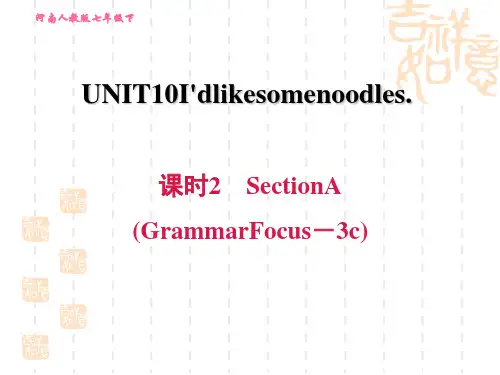
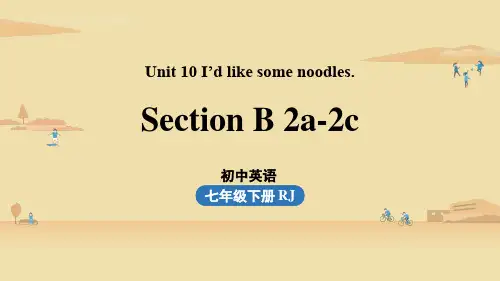
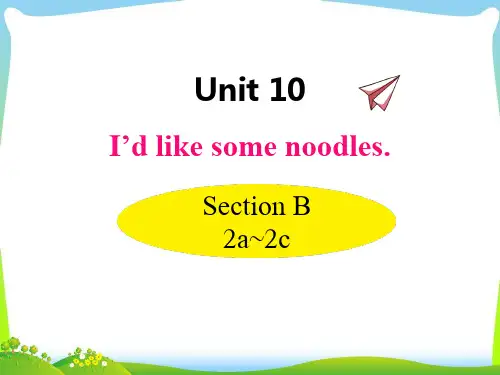
![【配套K12]七年级英语下册 Unit 10 I’d like some noodles Section A(Grammar Focus-3c)课后作业 (新版](https://uimg.taocdn.com/8ec3df42de80d4d8d15a4fd6.webp)
Unit 10 I’d like some noodles一、根据句意及汉语提示完成单词1.I want a bowl of __________ (面条). I'm hungry.2.Mary wants to buy a sweater for her mother, but she doesn't know the__________ (尺寸).3.We can get __________ (牛肉) and milk from cows.4.China is a __________ (大的) country with a long history.5.There are many kinds of __________ (肉) in the shop, like chicken and mutton.二、根据汉语意思完成课文原句或原句改编6.你想要什么?What ________ you ________?7.牛肉汤里有蔬菜吗?Are there any vegetables in the ________ ________?8.你想要什么种类的面条?________ ________ ________ noodles would you like?9.你想要多大碗的?________ ________ would you like?10.你想要一份大碗的吗?Would you like ________ ________ ________?三、根据句意及汉语提示,填入恰当的词完成句子11.—When can you finish the work?—I'm not sure ________ (还).12.Beef noodles and dumplings are their ____________ (特价品).13.The ________(土豆) look nice.Let's buy some.14.What are their ________(点的菜肴)?15.I ________(愿意) love to drink a cup of tea.四、用所给词的适当形式填空16.I need some________(mutton)to cook dinner.17.There ________ (be) some juice and apples in the fridge (冰箱).18.Jim would like________(have) some beef and carrot noodles.19.—What would you like?—I'd like some____________(cabbage) noodles.20.(N)This machine is ________ (special) designed for blind people.五、用适当的介词填空21.There is nothing ________ the cup. It is empty.22.These kinds ________ clothes are very good and sell well.23.What ________ having some chicken soup. It's very delicious.24.I would like to go to the park ________ my brother after school.25.You can get a special ________ free in this restaurant.六、单项选择26.—What ________ of noodles would he like?—Tomato and egg noodles.A.kind B.size C.color D.fruit27.I like tomato noodles,but my sister likes noodles________ chicken. A.have B.has C.with D.of28.Those ________ doctors would like some ________ noodles.A.woman; tomato B.women; tomatoesC.woman; tomatoes D.women; tomato29.(中考·黄冈)—What ________ bowl of noodles would you like,small, medium or large?—A large bowl of beef noodles, please.A.color B.price C.size D.kind30.—Would you like some ________?—Oh,yes,just a little.A.rice B.carrots C.eggs D.bananas31.—Is there any tea in the cup?—________.A.Yes, it is B.No, it isn'tC.No, there isn't D.No, there aren't32.(2015·哈尔滨)Health is important for us teenagers, so we should eat more vegetables such as ________ to keep healthy.A.tomatoes and potatoesB.tomatos and potatosC.tomatos and potatoes33.—Did you read today's newspaper?—No, I didn't. Is there ________ in it?A.something importantB.anything specialC.new anythingD.good something34.(2015·遵义)A:Can I help you,madam?B:I want ________.A.two boxes of appleB.two glass of waterC.two bowls of porridge35.(2015·德州)—Would you like to come to dinner tomorrow evening?—________A.Yes, it's true. B.You really do.C.It's upstairs. D.Yes,I'd love to.七、语法专练:按要求改写句子36.I'd like mutton noodles.(改为一般疑问句并作肯定回答)________ ________ ________ mutton noodles?Yes,________.37.She'd like a small bowl of soup.(对画线部分提问)________ ________ bowl of soup would ________ like?38.Miss Miller would like potato__and__cabbage noodles.(对画线部分提问)________ ________ ________ noodles ________ Miss Miller________?39.My father wants a large bowl of egg noodles.(改为同义句)My father ________ ________ a large bowl of egg noodles.40.There is some meat in the tomato and egg soup.(改为一般疑问句并作否定回答)________ ________ ________ meat in the tomato and egg soup?No,________isn't.八、根据汉语意思完成句子41.桌子上有一碗羊肉汤。
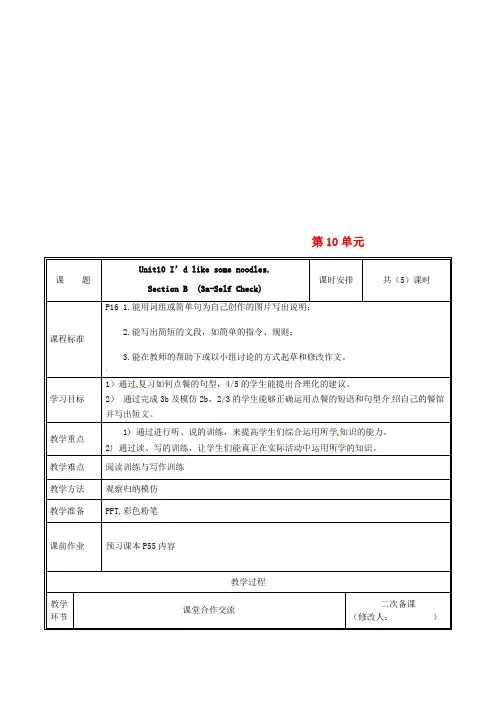
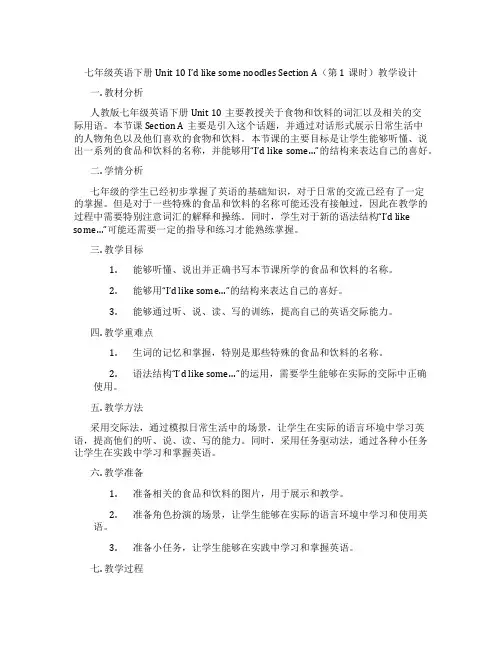
七年级英语下册Unit 10 I’d like some noodles Section A(第1课时)教学设计一. 教材分析人教版七年级英语下册Unit 10主要教授关于食物和饮料的词汇以及相关的交际用语。
本节课Section A主要是引入这个话题,并通过对话形式展示日常生活中的人物角色以及他们喜欢的食物和饮料。
本节课的主要目标是让学生能够听懂、说出一系列的食品和饮料的名称,并能够用“I’d like some…”的结构来表达自己的喜好。
二. 学情分析七年级的学生已经初步掌握了英语的基础知识,对于日常的交流已经有了一定的掌握。
但是对于一些特殊的食品和饮料的名称可能还没有接触过,因此在教学的过程中需要特别注意词汇的解释和操练。
同时,学生对于新的语法结构“I’d like some…”可能还需要一定的指导和练习才能熟练掌握。
三. 教学目标1.能够听懂、说出并正确书写本节课所学的食品和饮料的名称。
2.能够用“I’d like some…”的结构来表达自己的喜好。
3.能够通过听、说、读、写的训练,提高自己的英语交际能力。
四. 教学重难点1.生词的记忆和掌握,特别是那些特殊的食品和饮料的名称。
2.语法结构“I’d like some…”的运用,需要学生能够在实际的交际中正确使用。
五. 教学方法采用交际法,通过模拟日常生活中的场景,让学生在实际的语言环境中学习英语,提高他们的听、说、读、写的能力。
同时,采用任务驱动法,通过各种小任务让学生在实践中学习和掌握英语。
六. 教学准备1.准备相关的食品和饮料的图片,用于展示和教学。
2.准备角色扮演的场景,让学生能够在实际的语言环境中学习和使用英语。
3.准备小任务,让学生能够在实践中学习和掌握英语。
七. 教学过程1.导入(5分钟)通过展示一些食品和饮料的图片,引导学生谈论他们喜欢吃的食物和饮料。
2.呈现(10分钟)展示本节课的主要内容,通过图片和文字的形式呈现本节课的主要词汇和句子结构。
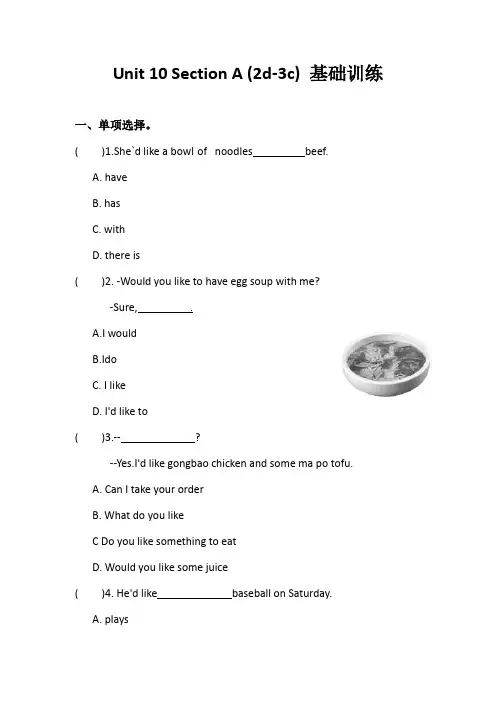
Unit 10 Section A (2d-3c) 基础训练一、单项选择。
( )1.She`d like a bowl of noodles beef.A. haveB. hasC. withD. there is( )2. -Would you like to have egg soup with me?-Sure, .A.I wouldB.IdoC. I likeD. I'd like to( )3.--?--Yes.I'd like gongbao chicken and some ma po tofu.A. Can I take your orderB. What do you likeC Do you like something to eatD. Would you like some juice( )4. He'd like baseball on Saturday.A. playsB. playC. playingD. to play .( )5.《兰州市中考)I paid ¥10 for this morning.A.4 bottles(瓶) milksB.4 bottles of milkC.4 bottles of milksD.4 milk二、根据句意和首字母提示写单词。
1. -May 1 take your o?-Yes. A bowl of egg soup .2. There are many kinds of m in the shop, like chicken and mutton.3. You can have some s when you're in the restaurant .4.-Would you like a large bowl?--No,I'd like a m bowl,5. Bob usually eats a bowl of rice and a bowl of m soup for lunch.三、根据汉语意思完成句子。
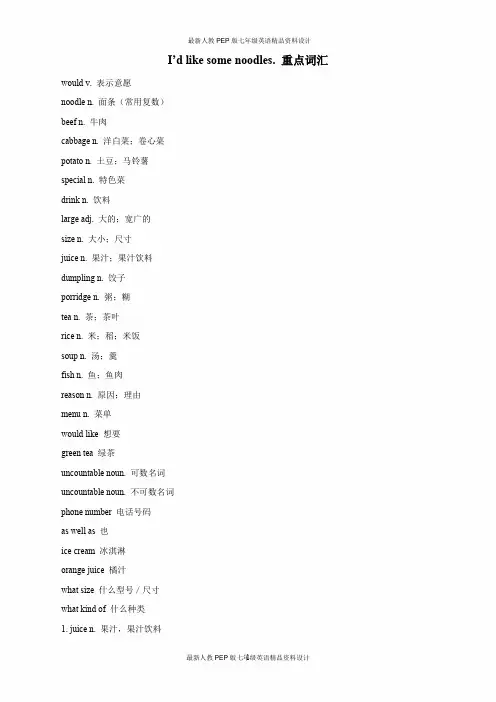
I’d like some noodles. 重点词汇would v. 表示意愿noodle n. 面条(常用复数)beef n. 牛肉cabbage n. 洋白菜;卷心菜potato n. 土豆;马铃薯special n. 特色菜drink n. 饮料large adj. 大的;宽广的size n. 大小;尺寸juice n. 果汁;果汁饮料dumpling n. 饺子porridge n. 粥;糊tea n. 茶;茶叶rice n. 米;稻;米饭soup n. 汤;羹fish n. 鱼;鱼肉reason n. 原因;理由menu n. 菜单would like 想要green tea 绿茶uncountable noun. 可数名词uncountable noun. 不可数名词phone number 电话号码as well as 也ice cream 冰淇淋orange juice 橘汁what size 什么型号/尺寸what kind of 什么种类1. juice n. 果汁,果汁饮料juice用作不可数名词,指果汁或果汁饮料。
I like orange juice very much. 我非常喜欢喝橘汁。
2. size n.(1)(……的)大小例:① I don’t know the size of his room. 我不知道他房间的大小。
② It’s about the size of a football. 它和一个足球的大小差不多。
(2)(鞋子、衣服等的)尺寸,号码,型号例:① What size shoes do you want to buy? 你想要买几号的鞋?② Can you show me any smaller sizes in this style?你能给我看一些款式相同但尺寸小一点儿的吗?③ What size hat would you like? 你想要多大号的帽子?3. large adj. 大的;宽大的;大规模的辨析large,big与great(1) large意为“大的,宽大的,大规模的”,与small相对。
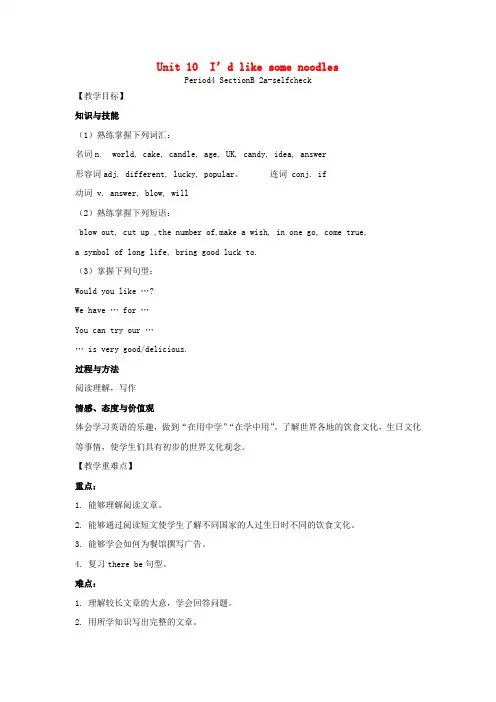
Unit 10 I’d like some noodlesPeriod4 SectionB 2a-selfcheck【教学目标】知识与技能(1)熟练掌握下列词汇:名词n. world, cake, candle, age, UK, candy, idea, answer形容词adj. different, lucky, popular。
连词 conj. if动词 v. answer, blow, will(2)熟练掌握下列短语:blow out, cut up ,the number of,make a wish, in one go, come true,a symbol of long life, bring good luck to.(3)掌握下列句型:Would you like …?We have … for …You can try our …… is very good/delicious.过程与方法阅读理解,写作情感、态度与价值观体会学习英语的乐趣,做到“在用中学”“在学中用”。
了解世界各地的饮食文化,生日文化等事情,使学生们具有初步的世界文化观念。
【教学重难点】重点:1. 能够理解阅读文章。
2. 能够通过阅读短文使学生了解不同国家的人过生日时不同的饮食文化。
3. 能够学会如何为餐馆撰写广告。
4. 复习there be句型。
难点:1. 理解较长文章的大意,学会回答问题。
2. 用所学知识写出完整的文章。
【导学过程】一.新课预习阅读2b,翻译下列词组。
在世界各地_______________ 茶油蜡烛的生日蛋糕______________________蜡烛的数目____________ 许个愿望______________ 吹灭蜡烛_______________ 受欢迎________________ 切碎__________________吃长寿面_______________ 给某人带来好运______________________二. 情景导入Have Ss discuss the question in 2a as a class.T: What do you do or eat on your birthday?S1: Have a birthday party.S2: Get some gifts from family and friends.S3: Eat birthday cake.S4: Eat noodles.T: Do you know why we will do all of these things on birthdays? Let’s read the article in 2b together.通过和学生讨论生日时吃什么、做什么自然过渡到阅读文章,并设下悬念,即为什么生日时要做哪些事情。
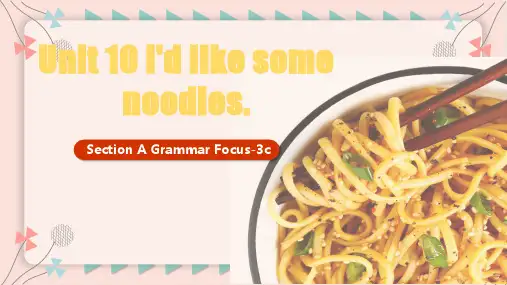
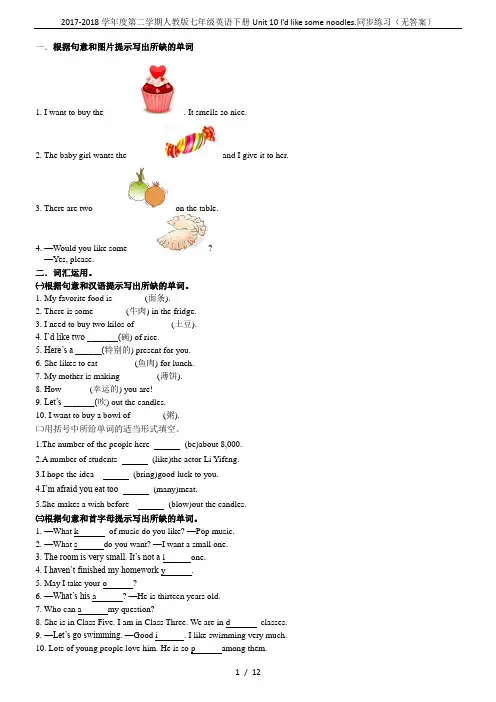
一.根据句意和图片提示写出所缺的单词1. I want to buy the _______. It smells so nice.2. The baby girl wants the _______and I give it to her.3. There are two ______on the table.4. —Would you like some ______?—Yes, please.二.词汇运用。
㈠根据句意和汉语提示写出所缺的单词。
1. My favorite food is _______(面条).2. There is some _______(牛肉) in the fridge.3. I need to buy two kilos of ________(土豆).4. I’d like two _______(碗) of rice.5. Here’s a ______(特别的) present for you.6. She likes to eat ________(鱼肉) for lunch.7. My mother is making ________(薄饼).8. How ______(幸运的) you are!9. Let’s _______(吹) out the candles.10. I want to buy a bowl of _______(粥).㈡用括号中所给单词的适当形式填空。
1.The number of the people here (be)about 8,000.2.A number of students (like)the actor Li Yifeng.3.I hope the idea (bring)good luck to you.4.I’m afraid you eat too (many)meat.5.She makes a wish before (blow)out the candles.㈢根据句意和首字母提示写出所缺的单词。
目标根据文章找寻关键信息,提高阅读能力。
重难点根据文章找寻关键信息,提高阅读能力。
授课类型阅读课授课内容Section B 3a-selfcheck五环教 学 流 程 与 设 计我的修改自主学习(课前预习)一.翻译1. 全世界___________2. 许愿 ______________3. 生日蛋糕____________4. 吹蜡烛______________5. the number of_______6. 切碎_________________7. symbol __________ 8. 受欢迎 ______________9. 相同 不同________ 10. bring good luck to_________合作学习运用(课中释疑)1.解决疑惑 自主互助学习。
2.自主学习听音朗读单词和2b课文。
探究学习展示(课中做)1. People have birthday cakes withcandles.人们吃带有蜡烛的生日蛋糕。
1). with:China is a country with a longhistory. 。
The girl with long hair is my sister. 。
2)with.He was writing with a pencil. 他在用铅笔写字。
2.The birthday person must make a wish and blow outthe candle.make a wish blow out3.In China , it isgetting popular to have cake on yourbirthday.在中国,在你生日的时候吃蛋糕愈来愈流行。
此句中it 是形式主语,真正的主语是不定时to have cake on yourbirthday.get popular 变得流行。
自主学习(课后巩固)一.单选。
1.The girl _____long hair is my sisterA .inB ofC forD with2.If it _____tomorrow ,I____ go to Ning Yang.A rain, won’tB rains ,willC rains ,won’t Drain, won’t3.It’s not easy for us _____English well.A learnB learnsC learningD to learn4.The large cake ___ eggs on it is just 10 yuan .A. hasB. haveC. withD. is二.单词连成句子。
I’d like some noodles
Section A 第2课时(2a〜3c)
自主学习方案
1.自学生词,并记住拼读及拼写。
2.预习课本找出重点短语及句子。(见学案自学导练内容)
3.读记后完成自学导练内容。
课堂导学方案
Step1 情景导入
Teacher:Do you like noodles?What kind of noodles do you like?
Student l:Yes,I like noodles very much. And I like beef noodles with vegetables.
Teacher:What about you?
Student 2:I like tomato noodles.
环节说明:通过师生互动复习上节课的内容,并且为新课的学习打下了基础。
Step 2完成教材2a-2c的任务
1.学生先观察图片,再和相对应图片匹配,最后 完成la的听力任务。(5分钟)
2.听录音,完成2b填空,核对答案后大声朗读句子。(3分钟)
3.听第三遍录音,跟读并整体感知对话内容。(2分钟)
4.两人一组,根据2b中的信息来练习对话,并邀请几组表演。(3分钟)
参考案例:
A:What kind of noodles would you like?
B:I,d like beef noodles.
Step3完成教材2d的任务
1.学生自读对话,根据对话内容完成下列句子(5分钟)
(1)Sally would like some vegetables in the beef soup.
(2)Sally would like one large bowl of beef soup, one gongbao chicken,one
mapo tofu with rice in all.
2.大声朗读2d对话,读熟后与同伴结对练习,分 角色表演对话。(3分钟)
3.创设情景:假设部分同学是服务员,另一部分是顾客,来练习对话。(5分钟)
4.小结训练。(3分钟)
A : What l of soup would you like?
B:I,d 2 egg and tomato soup.
A:Well,what 3 bowl of soup would you like?
B: What sizes do you have?
A:We have 4 ,medium and small bowls.
B: Oh,a medium 5 ,please.
l.kind 2. like 3.size
4.large 5. one
环节说明:将对话转化成填空题,这样能对所学的重要句型起到复习巩固的作用。
Step 4 完成 Grammar Focus
参考学案p. 68单元语法透析归纳语法知识并完成配套练习。
Step 5完成教材3a—3c的任务
1.认真读3a的两组句子,然后将两组句子组成一个完整的对话,集体核对答案。(3
分钟)
2.两人一组练习对话,学生也可以根据自己的实际情况来练习,并请几组学生表演,完
成3a。(3分钟)
3.让学生利用所给的信息提示来写出问题和答语,并请学生将答案展示在黑板上。要求
学生识记句子,两人一组互相提问,完成3b。(3分钟)
4.以小组为单位,每个学生用What would you like to eat?这个问题来采访其他的
学生,其他学生用3c中所给的食物进行回答,然后把学生的名字填 在相应的食物上面的卡
片上,最后利用采访的结果完 成一篇小短文。(5分钟)
参考案例:
In our group, X X would like hamburg¬ers. XXX and Kate would like tomato andegg
rice. XXX and X X would like beef and carrot noodles.
环节说明:通过本环节的学习,学生对前一阶段所学的知识进行复习巩固,同时也锻炼
了学生的口语和写作能力。
课堂资料包
Step 1重难点解析
1.May I take your order?请问您点菜吗?
本句为餐馆里服务员常用语。order此处用作可数名词,意为“点菜,订购”。例如:
I want to give the bookshop an order for this book.我想向书店订购这本书。
order也可用作动词,意为“点菜,预订”。例如: Would you like to order some
bread?你想不想来些面包?
The man ordered a table for six in the restaurant .这位先生在饭店里订了一张
六人位的桌子。
2.Is there any meat n the tomato and egg soup? 西红柿鸡蛋汤里面有肉吗?
(1)meat是不可数名词,意为“肉,肉食”。例如:Some animals, like tigers and
lions, eat meat.有些动物,如老虎、狮子是食肉的。
There' not much meat on that bone.那块骨头上没多少肉。
(2)短语 tomato and egg soup 中 tomato and egg 作名词soup的定语。名词作定
语,修饰名词时,修饰词一般为单数形式。例如:
She’d like beef and carrot noodles.她想要牛肉胡萝卜面。
There are many banana trees by the river.河边有许多香蕉树。
【拓展】当man,woman作修饰语,修饰名词复数时,它们本身也要变为复数。例如:
that woman teacher—those women teachers
3.I’d like beef noodles with carrots.我想要胡萝卜牛肉面。
介词短语with carrots作后置定语修饰名词beef noodles。beef noodles with carrots
相当于 beef and carrot noodles。其中with用作介词,意为“有,具有”。例如:
China is a great country with a long history. 中国是一个历史悠久的伟大国家。
— What size would you like?你要多大碗的?
— Large,please.请来大碗的。
what size是用来询问物体大小、尺寸的常用句型。 size是名词,意为“大小;尺码”,
既可表示物体的大小,又可用来表示服饰、鞋帽等的尺码、号码。例如:
—What size shoes does your father wear?你爸爸穿多大号的鞋?
—He wears size 8.他穿8号的。
What size is your apartment?你的公寓多大?
【拓展】medium意为“中号的”,表示物体的型号,可缩写为M。另外,small意为“小
号的”,可缩写为 S;large意为“大号的”,可缩写为L。
Step 2小结训练
1.一Well, my sons take great interest in most of the food on the menu.
—Thanks. D ?
一Yes, fried fish, beef, chips and cola, please .
A.Can I do for you B . At your service
C . What to follow D . Shall I take your order
2.All the D in our school enjoyed them¬selves on March 8th because it was their
own holiday
A.man teachers
B.men teachers
C.woman teachers
D.women teachers
3.Project Hope has built many schools D big classrooms and libraries.
A in B of
C.for D with
4.一What B noodles would you like?
一Small,please.
A kind B size
C kinds D sizes
Step3 家庭作业
完成课后提升作业(学案p.65)
教学反思
本课时以师生对话的方式自然引人新课,同时通过听、说、读、写相结合的方式巩固重
点知识,强化教学内容。